Regional Eurostar

Regional Eurostar was the name given to plans to operate Eurostar train services from Paris and Brussels to locations in the United Kingdom beyond London. The services would have been run using a fleet of seven North of London, 14-coach British Rail Class 373/2 trainsets.
Beginnings
When the Channel Tunnel was first announced in the 1980s, it was part of the proposals to operate high-speed rail services through it on both sides of the English Channel with a substantial network envisaged. This was gradually reduced to a core service, along dedicated TGV-style high-speed lines, between the three capital cities, regional daytime services to Glasgow Central via the East Coast Main Line and Manchester Piccadilly via the West Coast Main Line, and Nightstar sleeper services to the same cities as well as Plymouth and Cardiff via the Great Western Main Line.
A depot for the regional Eurostar services, Manchester International Depot, was constructed at Longsight in Manchester by London and Continental Railways. A large Eurostar-branded sign was attached to the outside of this depot which ambitiously proclaimed to passing train passengers "le Eurostar habite ici" (French for "the Eurostar lives here"), despite the fact that the depot was empty and unused; the sign remained in place for several years after the Regional Eurostar project was abandoned.[1]
Trial runs were undertaken using the 373/2 sets on both the East and West Coast Main Lines and passenger information signs and Eurostar lounges were installed at stations along the route. As the high-speed rail line between London and the Channel Tunnel, High Speed 1, was not under construction Eurostar services within the UK were forced to use existing rail lines and connecting junctions were built to allow Regional Eurostars access via the congested North London Line. In all British Rail invested £140 million in infrastructure to allow the services to operate.
Privatisation
Regional Eurostar services were never to run. At the same time as the Channel Tunnel was nearing completion. British Rail was undergoing the long process of privatisation and regional Eurostar can be seen as a victim of it.[2] Many had seen regional services as more a political than economic cause, a means of gaining support for the Channel Tunnel from areas of the UK outside the South-East. A Parliamentary Select Committee in 1999 said "The regions have been cheated".[3] The economic case for merely the inter-capital services had been questioned from the outset but by the time the Channel Tunnel was opened in 1993, backing for regional services had already started to dry up. The British Rail subsidiary European Passenger Services (EPS), which was to undertake Eurostar operations jointly with SNCF of France and NMBS/SNCB of Belgium, took ownership of the 373/2s in 1996 at the same time as it was under the process of being privatised and transferred to London and Continental Railways (LCR) who won the contract to build the CTRL and run Eurostar services.
Due to lower than forecast passenger numbers on the inter-capital services,[4] by 1998 LCR was in financial trouble. As part of a new deal with the UK government, in 1998 LCR sub-contracted its share of Eurostar operations, via Eurostar (UK), to InterCapital and Regional Rail (ICRR). As part of its bid ICRR stated that regional Eurostar services could not run without government subsidy, which the Department for Transport was unwilling to provide. The only other bidder to operate the UK share of the Eurostar operation for LCR, Richard Branson's Virgin Rail Group, claimed it was willing to run regional Eurostar services at its own risk, however it subsequently informed the UK government that it too saw them as unviable. As part of its contract LCR was not legally required to start regional Eurostar services and by 1999 it was clear that they would not operate.
British Rail, via EPS, ran a token domestic service from certain locations around the UK into Waterloo station using HSTs allowing connection with onward Eurostar service between May 1995 and January 1997 but these were ended at the time of privatisation.
Reasons given and criticism
Whilst officially regional Eurostar services have not been cancelled but are on hold or under review,[5] there are no longer many people who expect them to operate on current lines, although this may be reconsidered if the proposed High Speed 2 line comes to fruition. The most often cited reason given why they have not run is that they are economically unviable in the current climate.[6] The 1990s saw a huge expansion in air travel across Europe with low-cost airlines - a business that had not existed in Europe when the Channel Tunnel was planned - flying from most major cities in the UK to locations on the continent, against which regional Eurostar services, with predicted journey times of almost nine hours for Glasgow to Paris, could not compete.[7]
Unlike other international train services within the European Union where border controls have either had a long history of operation or are no longer enforced, the UK maintains concerns about customs and immigration. The inter-capital services still operate separately from the rest of the British railway network with passport checks carried out at St Pancras, Ebbsfleet International and Ashford International stations. There was concern that similar tight control would not be possible upon regional Eurostar services where separate check-in facilities at stations did not exist.
To stop regional Eurostar services competing with domestic services in the envisioned competitive market that it was hoped the privatisation of British Rail would create, they were not to stop in London and only allowed to pick up at regional stations whilst going south and set down passengers going north. This was cited as another negative reason for their economic non-viability.
The politics of the regional Eurostar service, along with many other Channel Tunnel-related projects, have been complicated over the years. In 1999 the Department for Transport commissioned Arthur D. Little Ltd to write an independent report into regional Eurostar service which was published in February 2000.[8]
Future



With the opening of High Speed 1 in November 2007, which has connections to both the East Coast Main Line and North London Line (for the West Coast Main Line) at St Pancras, there remains hope that the significantly improved journey times now available to potential Regional Eurostar services may make the service more viable. In addition, the maximum speed on the West Coast Main Line has been increased from 110 to 125 mph since the mid-2000s (though class 373s are at present limited by kinematic gauging constraints to 110 mph). Key pieces of infrastructure still belong to LCR via their subsidiary London & Continental Stations and Property (LCSP) such as the Manchester International Depot in Longsight.
While there has not been any official announcement of plans to start Regional Eurostar services, during recent enquiries into capacity on the East Coast Main Line it has been mentioned that Eurostar (UK) still owns several track access rights and the rights to paths on both the East Coast and West Coast Main Lines, hinting at the possibility of services at some point in the future.[10][11] But for the time being, at least, the nearest the UK has to Regional Eurostar services is the same-station connections now available at St Pancras from midland cities along the Midland Main Line route, e.g., Leicester and Sheffield.
Fresh plans have been proposed following announcements that a new high-speed line, High Speed Two (HS2), is to be constructed between London and Manchester and Leeds via Birmingham.[12] The proposed route of HS2 into London will bring the line very close to the existing High Speed 1 (HS1) line which terminates at St Pancras station; at their closest points, the two high-speed lines will be only 0.4 miles (0.64 km) apart, and the Department for Transport (DfT) examined various proposals for connecting HS1 and HS2. A governmental "command paper" published in March 2010 proposed either a rapid transit link between HS1 and HS2 terminals, or a direct railway connection.[13] Later announcements on 10 January 2012 confirmed that the first phase of the HS2 project was to include the construction of a single track link across North London between HS2 and HS1, partially in tunnels and partially over the existing North London Line, allowing for three trains per hour in both directions.[14][15] DfT proposals in 2013 stated that this link would allow HS2 trains from the North of England to bypass London Euston and connect straight to HS1, enabling direct rail services to be run from Manchester, Leeds and Birmingham to Paris, Brussels and other continental European destinations.[9][16]
The proposed HS1-HS2 link was subject to some criticism and concerns were raised by Camden London Borough Council about the impact on housing, Camden Market and other local businesses from construction work of the link.[17][18] Sir David Higgins, chairman of HS2 Ltd, recommended that the Camden railway link should be omitted from the parliamentary bill, stating that HS2 passengers from the North of England would easily be able to transfer from the HS2 terminal at Euston to St Pancras by London Underground, to continue their journey on HS1 to continental Europe. He also recommended that alternative plans should be drawn up to link the high-speed lines.[19][20] At the second reading of the High Speed Rail Bill in April 2014, the link was omitted from the final proposals.
Following this decision, there are no confirmed plans to connect HS2 to HS1, meaning that Regional Eurostar services are not longer being considered, although London mayor Boris Johnson proposed in April 2014 that an HS1-HS2 link should be provided by boring a tunnel under Camden.[21]
Routes
Due to track arrangements, customs and competition concerns and that the Eurostar terminal was located at Waterloo railway station on the south side of London regional Eurostar services were not to call at London. The Summer 1999 National Rail Timetable indicates the trains would have called at the following stations, with one train per day on the ECML Glasgow route, and two running to Manchester, one via the Trent Valley line and one via the Birmingham line. The faster train would not have called at stations between Stafford and Milton Keynes.
East Coast Main Line
- Glasgow Central
- Edinburgh Waverley
- Newcastle
- Darlington
- York
- Leeds
- Doncaster
- Newark North Gate
- Peterborough
West Coast Main Line
- Manchester Piccadilly
- Stockport
- Crewe
- Stafford
- Wolverhampton
- Birmingham New Street
- Birmingham International
- Coventry
- Rugby
- Milton Keynes
Slots in British Rail/Railtrack/Network Rail's timetables for regional Eurostar services were included for many years even though the services did not run. This factor was objected to by some train operating companies who were informed they could not run additional domestic services along the congested mainlines. The dropping of these slots around 1999/2000 was seen by many as the final admission that regional Eurostar services would not ever operate. However Eurostar still owns the rights to reinstate several paths in the future if desired.
Rolling stock
The trains to operate all these services were built at the same time as the Channel Tunnel was under construction in the late 1980s to early 1990s. The London-Paris-Brussels ("Three Capital" Class 373/1) trains are owned in groups by Eurostar International (subsidiary of LCR), SNCF and NMBS/SNCB but operate as a common pool. They consist of 18 coaches in a fixed formation. Seven shorter 14-coach North of London 373/2 were also constructed for the regional services at a cost of £180 million. All seven are owned by Eurostar International having been transferred from British Rail. Following the non-start of regional services, the trains were stored at North Pole depot in west London. Six of the seven trains have seen use at various times since.
Between 2001 and 2005, British East Coast Main Line operator GNER used three train sets to provide additional domestic capacity. Branded White Rose after the White Rose of Yorkshire, sets 3301–3306 received a deep-blue livery using vinyl wraps, with 3307–3312 being stripped of their Eurostar logos to fulfill the roster when the GNER-branded sets were unavailable. On occasions a GNER vinyled half set would operate with an unvinyled half set. Initially the GNER White Rose services ran between London Kings Cross and York, then, after clearance was given, between London and Leeds. The units were not permitted to be used on services north of York due to loading gauge restrictions in the Newcastle area. The sets continued to be maintained with the other Eurostar units at North Pole depot, where they returned to storage in 2005 following the end of the GNER lease. All bar 3308 were then leased to SNCF for domestic services in France.
Set 3313/14 was used during acceptance testing on section 1 of High Speed 1 and in the process of over-speed testing, set a new UK rail speed record of 334.7 km/h (208 mph) in 2003. The set is named Entente Cordiale and has seen use as a VIP charter train, having transported the Queen on a state visit to France and to the Entente Cordiale anniversary celebrations in 2004. On 12 June 2007 the unit was used to carry International Olympic Committee inspectors from Stratford International to London St Pancras, as a demonstration for Olympic Javelin services in 2012.[22]
The current future of the 373/2 sets remains uncertain. Software upgrades are believed to be required to allow the units to operate independently as a half-set; it is likely that the units will receive a similar paint-scheme to the Three Capitals Eurostar units already in use by SNCF for domestic service.
References
- ↑ Waterson, James (10 October 2011). "Taxpayers are funding rail depot for trains that only run in France". The Independent. Retrieved 12 May 2014.
- ↑ Harper, Keith (1999-12-10). "Prescott hopes for regional Eurostar fading". London: The Guardian. Retrieved 2009-08-04.
- ↑ "Environment, Transport and Regional Affairs - Fifth Report". Parliament of the United Kingdom. Retrieved 2010-04-05.
- ↑ "Select Committee on Public Accounts Thirty-Eighth Report". parliament.uk. Retrieved 2007-12-15.
- ↑ "Regional Eurostar services". dft.gov.uk. 2009-04-27. Archived from the original on 2007-07-17. Retrieved 2007-12-31.
- ↑ "Regions 'cheated' over Eurostar". BBC News. 1999-01-27. Retrieved 2007-12-31.
- ↑ "Eurostar extension in doubt". BBC News. 1999-04-28. Retrieved 2007-12-31.
- ↑ "Review of regional Eurostar services: summary report". Department for Transport. Retrieved 2008-01-20.
- 1 2 "High speed rail: investing in Britain 's future phase two - the route to Leeds, Manchester and beyond summary" (PDF). DfT. 23 January 2013. pp. 5, 16–17. Retrieved 13 May 2014.
- ↑ http://www.rail-reg.gov.uk/upload/pdf/272.pdf
- ↑ http://www.railwaysarchive.co.uk/documents/NR_EastCoastCapacity2005.pdf
- ↑ Green Gauge 21 - High Speed Two
- ↑ A National Strategy for High Speed Rail
- ↑ http://assets.dft.gov.uk/publications/hs2-maps-20120110/hs2arp00drrw05140issue2.pdf
- ↑ http://www.dft.gov.uk/topics/high-speed-rail/line-of-route
- ↑ "3. HS1-HS2 Link" (PDF). HS2 London – West Midlands Design Refinement Consultation. Department for Transport. May 2013. p. 21. Retrieved 12 May 2014.
- ↑ "HS2's cost to Camden". London Borough of Camden. July 2013. Retrieved 12 May 2014.
- ↑ "HS2 plans 'threaten jobs' in Camden's markets". BBC News. 21 November 2013. Retrieved 12 May 2014.
- ↑ "HS2 boss calls for rail link threatening Camden markets to be axed". Ham & High. 17 March 2014. Retrieved 12 May 2014.
- ↑ "HS2 chair Sir David Higgins urges project speed-up". BBC News. 17 March 2014. Retrieved 12 May 2014.
- ↑ "London mayor Boris Johnson calls for tunnel to link HS2 at Euston to St Pancras". Evening Standard. 22 April 2014. Retrieved 12 May 2014.
- ↑ "Olympic inspectors try out Javelin high speed rail link".
External links
- Arthur D. Little; Oscar Faber, Halcrow Rail; Prof. Roger Vickerman, Prof. Rigas Doganis (c. 1999). "Review of regional Eurostar services: summary report (dead link)". DfT Rail Group. Retrieved 2007-12-01. Cite uses deprecated parameter
|coauthors=(help) - "Review of regional Eurostar services: summary report". DfT. 2006. Retrieved 2014-04-08.
- Official report into Regional Eurostar by the Department for Transport.
- BBC report from 1999 about the failure to run services.
- High Speed Rail to the North.
- Armitstead, John (January 1998). "Photograph of Eurostar 3309/10 at Manchester Piccadilly". Archived from the original on 2 January 2011. Retrieved 29 May 2014.